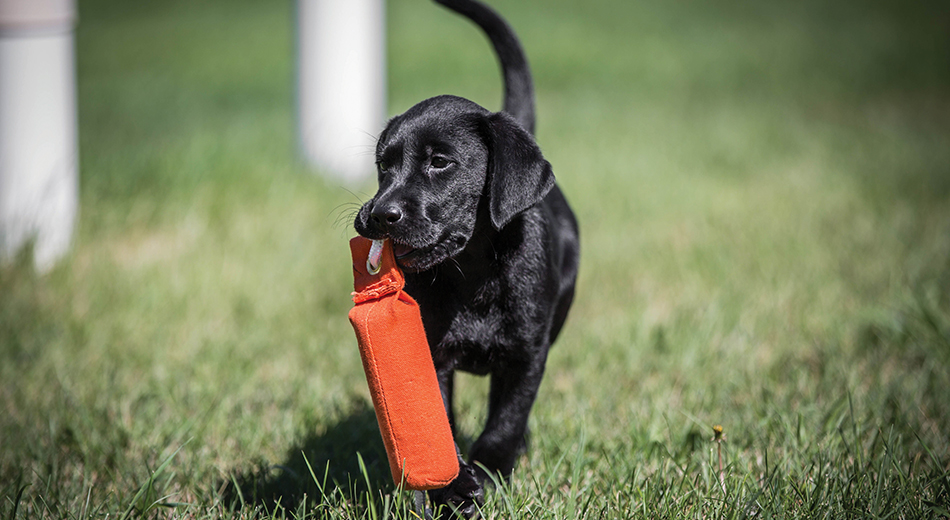
What’s in a Name?
A working retriever’s name requires added considerations
When I want to get the attention of the dog curled up in the corner of my office right now, all I have to do is utter the name of the elongated, orange, root-vegetable that grows in the garden: “Carrot.”
We acquired the tiny liver and white springer when she was 5 years old, and she came with that name. Her name is actually “Karat,” but people still give odd looks and require an explanation every time we introduce her. I’m convinced the breeders’ grandkids picked out the name “Carrot,” and they scrambled to come up with a version that somehow made sense. So our standard reply to a sideways glance is, “No, it’s Karat with a K. You know, as in diamonds and gold.”
Karat came to our household as a started dog who had spent several seasons as part of the breeders’ South Dakota pheasant hunting operation. Pleased by all that experience and well-trained field work, we decided to keep her name. Why mess with something that works just to avoid funny looks?
Let’s admit it. Picking a name for a dog is not brain surgery. Even so, there are a few things to remember.
Keep it Simple
First of all, we are not talking about the names that go on registry papers. When it comes to those, there are specific restrictions on length, whether they’ve been used before, punctuation marks and profanity. Additionally, breeders of highly pedigreed and proven dogs — the kind you need to be interviewed to buy — require the kennel name be included if there’s a chance you’ll breed the pup someday.
The tips that follow are for choosing a “call name.” That’s the name by which you’ll call the dog in the field and every day of its life for that matter. No matter what name is on its papers, the call name can be most anything you want it to be. However, unusual monikers like “Karat” aside, there are things to consider that will make your dog’s life — and yours — easier.
Frequently, call names are a shortened version of the registered name. Our male yellow Lab was registered as “Day’s End I’m Your Huckleberry.” His call name was Huck. I think that was a great call name unless someone misheard it in the wrong context.
The most important advice is to stay away from names that are too long or too complicated to say. “Huck-le-ber-ry” — four syllables — just would not have cut it as a call name. One- or two-syllable call names are usually the best. Blaze, Jax, Dixie and Radar are good examples.
Stick with names that allow you to apply some force and volume. Compare Bingo versus Sister. Ruby versus Esther. Jet versus Sierra.
Avoid Command Confusion
Avoid names that sound too much like common commands. Teal could be confused with “heel” unless you always make it a point to hit the “T” hard. With distractions, “Joe” might be mistaken for “no” or “Crown” with “down.”
You can further prevent that by testing your dog’s steadiness using words that begin similarly to the dog’s name. Our first Lab’s call name was “Sadie.” To make sure she was listening (and to show off for an audience) I’d throw a gimme mark, or even a flier and get her locked in on the bird. Then I’d say, “S-s-s-s-seven.” Usually she’d sit there, maybe just lean forward a little bit more. Then I’d say, “S-s-s-s-s-sensational.” You get the idea.
If she released on anything but her name, I’d call her back and pick up the mark without her retrieving it. If she waited it out, she’d get an excited “Sadie” and enjoy the reward of making the easy retrieve.
Don’t Get Weird
And then there are just “odd” names. You might decide to use one, but you have to consider the implications. For example, as a trial and hunt test competitor, I always thought about naming a dog “Judge” if only to see the reaction of the judges when I gave commands. I didn’t. It would have just been a bad idea.
Another name that crossed my mind when I was younger and a lot more competitive was “Hardcore Nitro Psycho” with the call name of “Psycho.” That also would likely have been a bad idea.
We did name a dog “Calamity Jane” with the call name “Callie.” It was against the advice of a friend who said, “Be careful. Dogs sometimes become their names.” Sadly, Callie died young in a very calamitous way.
Unleash Potential
A big part of the fun of acquiring a new puppy, especially for a family, is coming up with the new dog’s name. You’re starting with a clean slate and you can, quite literally, choose to name the dog anything you want. For every good pup I see, one word always springs to mind first. That is “potential” — and choosing the right name can be a springboard to unleashing it.
Our Karat is a wonderful dog. She loves to hunt. She loves to retrieve — if the going isn’t too tough. Like most springers, she’s a bundle of energy and affection in a compact package. Whether her name is “Carrot” or “Karat” doesn’t change a thing.
So to badly mangle the paraphrase of a Johnny Cash standard, “Life ain’t easy for a dog named Carrot. And if I ever name another pup of my own, I’ll call it … Brownie or Rover or Bingo, anything but Carrot!”
